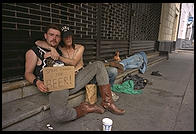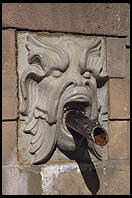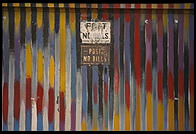
It Takes a Pillage
reviewed by Philip Greenspun; January 2010
Site Home : Book Reviews : One Review

|
It Takes a Pillagereviewed by Philip Greenspun; January 2010
Site Home : Book Reviews : One Review |
This is a review of
It Takes a Pillage: Behind the Bailouts, Bonuses, and Backroom Deals from Washington to Wall Street
by Nomi Prins, a former managing director at Goldman Sachs.
The big value of this book, by a former Wall Street insider, is that it reminds us that the Collapse of 2008-? was not something caused by an impersonal system. The Collapse and subsequent bailouts were caused by individuals acting in their rational self-interest. Prins has collected hundreds of individual stories and backed them up with references.
Back in 2009, a cousin argued that Wall Street had blown up because people were greedy. I replied that he would have done exactly the same as the Wall Street looters. He was outraged. I asked "What if you could flip a coin and, if it came up heads you'd earn $1 billion for your employer [an animation studio] and take home $500 million of that as a bonus. But if it came up tails, you'd bankrupt the studio and have to find another job. Would you flip the coin?" Of course not! He was offended by the very idea. I pressed him, though. "How could you deny your family the opportunity to gain $500 million, simply out of a selfish desire to keep your current job?"
We set up the rules for Wall Street traders and executives just like
the hypothetical that I gave my cousin. Any rational person in their
situation would have behaved as they did. Prins, in
It Takes a Pillage,
gives us the specifics, starting off with the big picture:
(from page 3) Washington has collectively and in a bipartisan manner demonstrated the most knee-jerk and expensive approach to groping toward financial stability in human history. ... The strategy that [Tim Geithner unveiled on March 23, 2009] to "fix" the financial system was to ask its most reckless and opaque companies--the ones that shirked the most taxes and took the most selfish and irresponsible risks--to buy up Wall Street's junkiest assets in order to rid the system of its own clutter. The worst part? The government would front them most of the money to do it.
Prins has worked hard to quantify the scale of the transfer of taxpayer funds to favored Wall Street banks and a handful of bank-like firms. She maintains a continuously updated calculation on her Web site. As of December 2009, the number stood at 11.5 trillion dollars, plus another $2 trillion. Her analysis is unconventional in that it takes into account the government assumption of Fannie Mae liabilities, for example.
The same page also includes "The Pillage People", tallying up how much various government officials have handed out, and a compensation overview, comparing total bank employee compensation to total federal subsidies (for 2009, she has the banks paying out $124 billion and receiving $116 billion in subsidies).
On page 43, Prins points out that there were only $1.4 trillion in subprime mortgages outstanding in the U.S. and $11.9 trillion of total residential mortgages, so the only explanation for why so much money was needed was leverage. Her explanation of how exactly leverage was used is confusing. She provides a bit better explanation of the credit default swap market, which grew to $45 trillion: "In an incentuous frenzy, institutions bought and sold credit protection to one another, with money they borrowed from one another. ... The global fallout might have been manageable if banks hadn't entered this massively interconnected circle of privately negotiated CDSs." AIG, of course, was the biggest bailout recipient and the biggest seller of CDSs. Prins quotes a Deutsche Bank executive who "saw that pay incentives and lack of oversight from management had led to excessive risk taking [in 2006]." He explained that "the employees writing and signing off on the contracts get paid in the short term..."
The book has the details of how the money was spent, but it does not clarify the picture. For example, page 34 talks about a February 2009 House hearing in which it was established that for the first $254 billion spent under TARP, the government received assets worth only $176 billion. Prins does not explain how the value of the assets was established. On page 35 we learn that Treasury got a much worse deal when it put TARP money into Goldman than did Warren Buffett, at roughly the same time.
Page 41 treats Timothy Geithner's arrival as Treasury Secretary. "Geithner had the option of coming up with a different plan to stabilize the banking system, rather than purchasing shares in its unwieldy firms. ... He went back to Paulson's original plan of buying up toxic assets, with a twist. Under Geithner's public-private partnership plan, we the people wouldn't buy the assets directly and hope that they have value someday. We would be asked to loan money to private firms to buy them for us--up to $1 trillion worth. If the assets have value later, those private firms will make most of the profit on them. And if they don't? Well, then we're out another trillion or so."

Much of the money doled out was to Wall Street investment banks but from programs intended to stabilize Main Street banks. The lines were blurry ever since the Clinton-era repeal of Glass-Steagall and all of the Wall Street I-banks darted over the line to become "bank holding companies". Prins notes that this gave "Morgan Stanley and Goldman Sachs easy access to massive lines of credit [with the Fed]. For those of you keeping score at home: change of status equaled river of free money." The Wall Street Journal said that "Wall Street's two most prestigious institutions will come under the close superivision of national bank regulators, subjecting them to new capital requirements, additional oversight, and far less profitability than they have historically enjoyed." [This turned out to be wrong; 2009, with its river of free money, was the most profitable year ever for Goldman Sachs.] The mechanism is explained on page 112: "the Fed used a sleight of hand it had honed for decades to take on trillions of dollars in useless assets, giving cheap loans in return to the very banks that had created the bad assets."
American Express decided that it too was a bank and could dip its toe into the river of free money. The CEO Kenneth Chenault said "Given the continued volatility in the financial markets we want to be best positioned to take advantage of the various programs the U.S. government has introduced or may introduce." Chenault's friends on the Amex board paid him $26 million in 2007. In 2008, a terrible year for shareholders, he received $27 million, just as the river of public money began to flow into Amex. GMAC became a bank as well, part of the $97 billion in public money consumed by GM and Chrysler.
What's the latest on these programs? According to CNN, January 26, 2010, the TARP program per se may not cost that much. The Wall Street banks are going to repay the money. AIG will cost $9 billion. GM and Chrysler are the black holes from which almost none of the $97 billion in public funds will emerge. As Prins points out in the book, however, TARP is really the cheapest of the programs. Giving banks money at zero percent interest is the costliest program and there is virtually no accountability.

Having worked at Goldman, Prins devotes a lot of attention to how this company has managed to obtain favorable treatment from an all-powerful federal government. The near-infinite supply of tax dollars and truly infinite supply of dollars that can be printed makes today's federal government the most important ally in any business.
When the Collapse of 2008 began, Goldman was positioned well due to its former CEO, Hank Paulson, being Secretary of the Treasury. Prins notes that Paulson had cashed out his Goldman stock, worth approximately $500 million, upon taking the Treasury post in 2006 and was able to indefinitely defer $100 million in capital gains taxes on the transaction as one of the perks of the new job. Paulson was involved in negotiations concerning whether his former competitor, Lehman Brothers, should be allowed to go broke. Prins describes Paulson's first proposal that TARP funds be used to buy worthless assets: "His friends made a series of bad bets, and now he wanted the government to cover their losses. What could be simpler?"
Page 198: "[Geithner] appointed Mark Patterson, a former Goldman Sachs lobbyist, as chief of staff at the Treasury. ... Patterson got the prime spot in the Treasury through a glaring loophole in the executive order on lobbyists that President Obama had issued a week earlier."
As of the summer 2009 writing of the book, Goldman had returned $10 billion in TARP money, but kept "$12.9 billion they got from the AIG bailout, the almost $30 billion of cheap debt they raised under the Temporary Liquidity Guarantee Program (TLGP), and the approximately $11 billion they still have available under the Fed's Commecial Paper Funding Facility LLC (CPFF)."
[In 2003, Goldman paid a fine to the SEC for defrauding investors by having its analysts hype stocks that it knew to be worthless, but from whose sale Goldman stood to profit handsomely.]

Politicians are already congratulating themselves on a couple of quarters of GDP growth and saying "imagine how much worse it would have been if we hadn't bailed out those banks." For young people worried about working for a lifetime to repay debts incurred by the Congress in 2008, 2009, and 2010, or for those unable to find work, those congratulations will ring hollow. Prins explains why the bank bailout did not help the economy.
Early in the book, Prins decries the fact that the bailouts of 2008/09 were not provided directly to consumers for auto, home, and student loans. She then explains that changes in Fed policy encouraged banks to sit on their money by paying them extra interest on money parked with the Fed. "American banks kept $44 billion in reserves with the Fed. By the end of 2008, that number soared to $821 billion. And by May 2009, it hovered just below $1 trillion."
The unemployment numbers aren't nearly as bad as in the Great Depression, but a lot of that is because we've changed the way that we calculate unemployment. On page 135 Prins notes that "In 1933, at the peak of the four-year depression, around 1,000 homes were foreclosed every day. ... By comparison, 10,000 homes were foreclosed daily by early 2009." The population has grown since 1933, of course, but not tenfold.

Prins and her researchers tried to get information out of the ratings agencies, Standard and Poor's, Moody's, and Fitch. These were the folks who rated so many of the subprime-based products "AAA" in exchange for fees from the banks issuing those products. "If the agencies did not provide good scores, CDOs weren't created, and the agencies wouldn't get paid." The agencies refused to divulge how much they were typically paid by the investment banks. Prins suggests that they be nationalized.
In some ways the entire Collapse of 2008-? may be due to Citigroup. "In July 1999, Robert Rubin abruptly left the Beltway at the height of his prestige. On the day he resigned, after four years as Bill Clinton's treasury secretary, ... [Rubin said]: "This has been a remarkable experience, but I was ready to go, ready to return to New York.' He said that he had 'only some very vague plans about what to do next.' [In November 1999] Rubin's plan really sharpened when he nabbed a plum spot at Citigroup. His appointment there happened to come a few days after Congress and the Clinton Administration agreed on the most massive piece of banking and financial deregulation in the country's history, the repeal of Glass-Steagall. ... Citigroup was the big winner in the legislation. ... Rubin himself said that he played a role in ironing out the bill's final version." Rubin took home $126 million from Citigroup over the next decade, according to Prins (sourced with one of the book's 1000 or so citations).
"Rubin placed a well-time phone call on November 8, 2001, a month before Enron's bankruptcy, to one of his pals in Washington, undersecretary Peter Fisher, who had been at the New York Fed while Rubin was the treasury secretary. He asked Fisher to call the ratings agencies on behalf of Enron [to persuade the agencies not to downgrade Enron]. Fisher declined. Enron's pending merger with Dynergy disintegrated, Citigroup lost the deal, and Enron filed for bankruptcy a month later--leaving Citigroup with lots of unpaid debts." Prins explains that this lobbying was legal "only because Bill Clinton, as one of his last acts as president, canceled an executive order that had prohibited officials from lobbying their own political stomping grounds on behalf of the private sector for five years after leaving office."
On page 39 we learn that because of the substantial assistance that Citigroup provided to Enron in running its off-book entities, the bank was required to file special quarterly risk-management reports with the New York Fed. "The Fed ended that requirement about the time that Citigroup started bulking up on its own off-book hiding spots, called structured investment vehicles (SIVs)."
[In 2003 Citigroup settled charges brought by the SEC that it helped defraud Enron investors. Separately, Citigroup had to pay a fine for its role in defrauding investors by having its stock analysts provide inflated ratings to companies that it knew were unsound (more at Washington Post).]

Merrill Lynch is renowned for collecting $10 billion in government aid and then paying out $3.6 billion of that in bonuses to the employees who had wiped out shareholders in a nearly century-old firm. The back story on Merrill is more interesting, however, than the public outrage concerning the bonuses.
I wrote about Stanley O'Neal at Merrill in this April 2008 blog posting. He destroyed a firm that was nearly a century old by placing huge bets on mortgage-backed securities. He transferred about $50 million per year of the shareholders' money into his personal checking account. Prins notes that he took another $161 million as a retirement gift when the Board finally threw him out, just about a year before Merrill went bust. Prins notes that O'Neal endured only three months of unemployment. He landed a job as a director on the board of Alcoa, approving the compensation of its executives.
Merrill's board hired a Goldman alumnus, John Thain, to replace O'Neal. He "topped the chart [of Wall Street pay for 2007], having worked for only one month", taking home $83 million (an annualized salary of $1 billion).
Merrill's poorly understood and catastrophic losses nearly brought down Bank of America, but not its employees. The chief risk officer, Amy Wood Brinkley, lost her job at Bank of America, but not before taking home $37 million of the shareholders' money. She was replaced by "Greg Curl who, ironically, was the lead negotiator for the Merrill acquisition."
[In 2003, Merrill paid a fine to the SEC for defrauding investors by having its analysts hype stocks that it knew to be worthless, but from whose sale Merrill stood to profit handsomely.]

Prins has a chapter entitled "We Already Have a Bad Bank: It's Called the Federal Reserve".
Page 124 explains that "member banks are required to subscribe to stock in their district's Federal Reserve Bank. The required subscription is equal to 6 percent of the bank's capital and surplus; 3 percent must be paid in. ... Member banks also receive 6 percent dividends on their shares, not too shabby in times of stock market turmoil, when no bank offers that to individual shareholders."
Prins ends the chapter with the following:
Big convoluted institutions drained trillions of dollars of public capital and wrecked the general economy. yet they are destined to remain financial mammoths because the Fed wouldn't let them go extinct. ... The Fed did an abysmal job of guarding the nation from Wall Street's excesses as they were building, and rather than admit or correct its errors, the Fed simply printed more money, in the hopes of shoving them under the rug. Yet both the Bush and the Obama administrations wanted to give the Fed more power as a systemic risk regulator. What does that say about the likelihood that all this will happen again?

Aside from the expected campaign contributions from Wall Street, some politicians received more direct aid. On page 163, Prins says that Countrywide, whose CEO took roughly $500 million out of the firm before it blew up, extended "favorable" loans to "high-ranking government officials, including Chris Dodd (D-CT) and Kent Conrad (D-ND), plus a slew of former Fannie Mae CEOs." Dodd remained chairman of the Senate Committee on Banking, Housing, and Urban Affairs; Conrad remained chairman of the Senate Budget Committee.
Page 105: "Former Bear Stearns CEO James Cayne sold his Bear stock--just two days after the [takeover by JP Morgan Chase] was completed--for $61 million. ... Most of that stock had been given to Cayne as part of his compensation package." Investors in the stock did not do so well. They paid as much as $140 per share and sold for $10, though even most of that was a gift from the taxpayer; JP Morgan Chase only bought the company because the government guaranteed Bear's losses with $29 billion in public funds.
Page 161: the AIG shareholders took a beating due to a $5 billion loss in Q4 2007, but CEO Richard Sullivan was rewarded with a $5 million bonus.
Page 166: Dick Fuld, who bankrupted Lehman, corrected reports that he'd taken $500 million out of the firm before its collapse. It was "somewhere near" $350 million. Public investors lost everything.
To quell public anger over massive "bonuses", Morgan Stanley renamed them "retention awards" (page 168).
Page 190: One of the chief architects of the ruin of AIG shareholders (and then the taxpayers), AIG chief financial officer Joseph Cassano collected $315 million in pay while leading the firm into the credit default swap (CDS) market. In August 2007, he said "It is hard for us, and without being flippant, to even see a scenario within any kind of realm of reason that would see us losing $1 in any of those transactions." In March 2008, he was forced into retirement. In September 2008, AIG became insolvent. Cassano was a 53-year-old retiree with a $315 million nest egg. AIG lost more in one year than all of the paper profits that it had declared during its nearly 100-year history (those paper profits were the basis of the big executive bonuses); approximately $180 billion in taxpayer money was required to prop up AIG.

On page 79, Prins says "The Federal Reserve and the Office of Thrift Supervision ... created an unstable environment in which more players needed to be watched. By not considering the consequences of their approvals, they allowed financial firms to easily become bank holding companies and insurance companies to become savings and loans ... AIG became one of the most extensive and complex S&Ls, and would ultimately conspire with its regulators to extort hundreds of billions of dollars of public money. That's a recipe for future disasters. So the stage is set for more government bailouts because any financial firms left standing, particularly those that have the government-sponsored stamps "BHC" and "FHC" will be able to engage in every single one of the behaviors that led to the Second Great Bank Depression ["Collapse of 2008-?" as I call it], even while being floated by government (read: public) money."
On page 141, Prins sings the praises of Glass-Steagall: "If it had not been repealed a decade ago, our current banking system meltdown would not have occurred. Deposits and loans would not have been used as collateral for an upside-down pyramid of risky securities." Senator Byron Dorgan, in 1999, said "I think we will look back in ten years' time and say we should not have done this but we did because we forgot the lessons of the past and that that which is true in the 1930s is true in 2010." He was only off by two years! The late Senator Paul Wellstone said "[Glass-Steagall] was designed to prevent a handful of powerful financial conglomerates from holding the rest of the economy hostage."
Surveying the wreckage of 2009, Bill Clinton had no regrets, as quoted by Prins. "[Repeal of Glass-Steagall] enabled them to, like the Bank of America, to buy Merrill Lynch here without a hitch. And I think that helped to stabilize the situation." Prins points out that Merrill's losses were so great that Bank of America needed $220 billion in capital and guarantees following the merger.
Prins discusses another little-known relatively recent destabilizing factor: starting in 2004, investment banks were allowed by the SEC to "increase their official leverage from twelve to one to thirty to one". In the case of Merrill, the Bush Administration SEC allowed them to go to 40:1.
Prins does not spend much ink on the fact that a publicly traded investment bank is a relatively new phenomenon. This New Yorker article explains that until 1970 the NYSE prohibited investment banks from going public. The I-banks went public in waves, culminating with the Goldman Sachs IPO in 1999. Prior to their public offerings, the executives were partners risking their own money and had a natural incentive to monitor risk. Following the public offering, the executives were risking their investors' money and, at worst, might have to find new jobs if they placed bad bets.
So... we gave everyone on Wall Street a totally different way of working, starting in the 1970s (from risking their own money to risking shareholder money and skimming off the proceeds from lucky bets). We made a huge change in 1999 by repealing Glass-Steagall and a big change in 2004 by upping leverage limits. Our economy melted down in 2008. It shouldn't be tough to undo these changes, right? Prins says "Washington is masterful at conducting lengthy, painful debates over minutiae, which sap the country's hope--not to mention the federal budget--and also distract us from undertaking more essential action on the profound structural problems. Expensive piecemeal remedies aimed at solving the financial system's total failure have continued through the Bush and Obama administrations."
In the final chapter of the book, Prins adds a little scorn to what she has already heaped on the Obama Administration. Obama talks about change, she says, but has only intensified the problems caused by previous administrations. The Clinton Administration repeal of the Glass-Steagall act is mourned yet again. Congress and Clinton allowed investment banks to engage in commercial banking starting in 1999 and we made it almost 10 years before a complete Great Depression-style meltdown. In addition to restoring Glass-Steagall, Prins suggests the following:
I don't think that she has made her case for regulatory reform. First, she has not sketched it in sufficient detail. Second, the collapse was not a failure of a free market. In a classical free market, the participants are subject to upside and downside risk. A Wall Street partnership that made a bad bet would find itself wiped out and its partners' mansions in Greenwich would be taken by counterparties. The government created the corporation so that a group of guys could take risks every day on Wall Street, pay out the profits to themselves as salary, and then, if a day came when there was a big loss, hand over the corporate shell to the counterparties and retire to their mansions. Then the government created the public corporation, in which Wall Streeters could take money from investors, place bets with it, take home the profits from winning bets as "bonus" and, once again, hand over a bankrupt shell when big bets went sour. SEC regulation would prevent the shareholders of a public company from having any meaningful way to control the diversion of profits away from the dividend stream that they expected and into employees' pockets.
Given the public corporation structure of Wall Street banks, the relevant question is not why they blew up but why it took so long.

In my economic recovery plan, I suggested that shareholders in public companies select and elect an independent board to represent their interests. I wrote this primarily with non-financial companies in mind, to keep the executives from packing the board with their golfing buddies and then looting from the shareholders. It is perhaps even more important for a Wall Street bank because when the bank is fully looted out the consequence seems to be that the taxpayer must step in to stop a system-wide panic.
In "Would someone please save shareholders from being helped by the government pay czar?" (October 2009) I proposed a general prohibition on public companies issuing new stock (diluting existing investors) to pay employees. They should have to use profits to buy back stock and then hold it in escrow for employees, along with some cash. If the company were still profitable five years down the road, the stock and cash could be released to the employees who'd demonstrably generated some long-term value. If the company were flailing, it could use the escrowed stock and cash to recover.
It Takes a Pillage: Behind the Bailouts, Bonuses, and Backroom Deals from Washington to Wall Street
is a great book for adding color to one's understanding of the
Collapse of 2008-?. The book is not sufficiently complete or clear
that it can stand alone in explaining the Collapse.
This book contains no figures, graphs, photos, or other illustrations. As such it would be fine for reading on a Kindle or similar electronic reader.